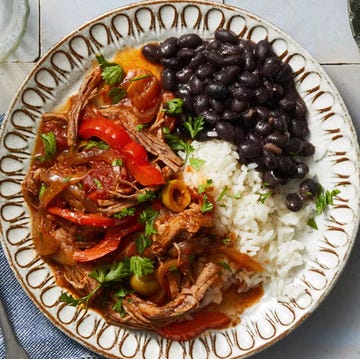Chances are, you’ve glimpsed the flavorful Japanese ingredient on restaurant menus, seen containers of it at the grocery store, or even cooked with it yourself, but what exactly is miso?
Miso is a fermented paste made from soybeans commonly used in many Asian recipes and is an incredibly versatile seasoning powerhouse worth stocking in your kitchen (especially because it will last a while!). The concentrated, savory flavor lends umami-forward flair to salad dressings, sauces, marinades, soups, sweets and more — the possibilities for delicious dishes using miso are truly endless, and there’s no shortage of ways to appreciate the salty, earthy stuff.
Whether you’re a miso newbie or a long-time devotee, we’ve got something for you. Read on for everything you need to know about this superstar staple, including its history, what it tastes like, the various types of miso (spoiler alert: there are way more than you may think) as well as what makes them different from one another.
We’ll also touch on how to store miso and how long it lasts, the amazing health benefits of miso (even more reason to make it part of your diet!) and provide some recipe inspo so you can incorporate its flavor-boosting potential into your cooking rotation, stat.
What is miso?
Miso is a fermented food made from soybeans, water, salt and a crucial ingredient: koji. Koji is a culture made from a grain like rice or barley (or soybeans) that’s been inoculated and fermented with a mold called Aspergillus oryzae. Think of this cool culture as the starter that kicks off the fermentation needed to produce miso (as well other foods like sake and soy sauce) with its distinctive umami taste, similar to how sourdough starter powers and flavors a loaf of crusty, tangy bread. The bottom line: When koji is combined with cooked soybeans, salt and water and the mixture is fermented over a period of time, miso results.
Where is miso from?
Miso likely originated over 1,300 years ago. It is derived from a Chinese food called chiang (or jiang) that was originally made from seafood or meat (miso now, however, is plant-based). It is said that the savory paste came to Japan from China around the time that Buddhism spread to the island nation, and as chiang was adopted by the country, miso and its various types were created. Now, miso is not only deeply embedded in the culture and food of Japan, but it has also made its mark as a well-known ingredient around the world.
What does miso taste like?
Depending on the ratio of ingredients, type of grain involved and how long it ferments, miso can run the gamut from sweet, light and mild to earthy and nutty to rich, bold and assertive (use color as a tool to broadly gauge the intensity of flavor; the darker the miso, generally the bolder the flavor). Despite the myriad varieties out there, you can expect characteristically savory, umami-centric flavor from all misos.
What are the different types of miso?
Miso Tasty sums it up aptly:
“Those new to miso are often surprised to learn that there are near-infinite types, just as there are countless varieties of wines or cheeses. If you adjust the ratio of soy to grain to salt, the environment, the length of fermentation, or the grains chosen, a different type of miso results.”
Given all these variables at play, there’s basically no end to the varieties of miso possible in the world. If that sounds overwhelming, we hear you! Here’s a short list of misos worth familiarizing yourself with:
Kome (rice) miso is made with white rice and is the most ubiquitous umbrella category of miso. More than 80% of Japan’s miso production is rice miso, which includes the following misos:
- White (shiro) miso is made with rice or barley koji, has a lighter hue and offers a mellow, sweet flavor due to its shorter fermentation period.
- Red (aka) miso has a deeper color and a saltier, more intense flavor because it’s fermented longer and contains a higher ratio of soybeans to koji.
- Yellow (shinshu) miso is somewhere between white and red miso in terms of flavor, with a pleasant acidity. It undergoes a longer fermentation than white miso, making it saltier than shiro, but not as bold as red miso.
- Awase miso is a mixture of white and red misos — AKA, the best of both worlds. This balanced blend is known for its versatility.
Mugi (barley) miso is made with barley koji and boasts a nutty, sweet-tinged earthiness.
Mame (soybean) miso is made from only soybeans (using soybean koji) and left to ferment for up to three years, giving it a deep hue and a rich, strong taste. Hatcho miso, a kind of mame miso hailing from the Aichi Prefecture, is a well-known sub-variety in Japan.
Genmai miso is made with brown rice, giving it a nutty profile laced with a bit of sweetness.
How long does miso last, and how do you store it?
Because miso is fermented, it will last for a while after opening — up to a year if refrigerated from the date of purchase, according to FoodSafety.gov — so don’t fret if it takes some time to get through your stash. For optimal storage, press plastic wrap directly on the miso before putting the lid back on and returning to the fridge (this helps slow down the oxidation process, though darkening in color over time is to be expected).
Is miso good for you?
Miso offers a slew of nutritional benefits (in fact, soy-based foods like miso are part of the Okinawa diet, a Blue Zone diet that’s been linked to longevity). As a fermented food, it boasts probiotics that promote better gut health, support a strong immune system and could help remedy constipation. “Miso is rich in enzymes that may improve digestion for some people and help the body absorb nutrients. Additional studies are necessary to verify miso’s role in preventing gastrointestinal conditions,” explains Valerie Agyeman, R.D. Miso also contains vitamin K, which assists in blood clotting, and brain-building nutrients and vitamins like choline, niacin and folate. It's also a source of complete protein because it has all nine essential amino acids.
One thing to consider is that miso is high in sodium — which, on the one hand, can be a good source of electrolytes for athletes in need of a recovery meal, but also something to keep in mind if you’re trying to moderate how much sodium you consume.
How do you use miso?
Consider miso your all-around kitchen MVP. “Miso has become my secret ingredient,” says GH's Chief Food Director Kate Merker, who adds a dollop of miso to her marinara sauce and subs anchovy with it in some vegetarian dishes. “It gives that salty hit but also adds a deep, rich flavor to any number of recipes.”
Miso’s earthy, concentrated umami flavor works wonders in dressings, sauces and marinades, as well as soups, stews and braises. In general, it’s best whisked with or into a liquid before using. A good rule of thumb when cooking with miso is to use the right variety depending on the application: Mild and mellow white miso is better-suited for dressings and condiments, lighter broths and white meats and fish, while comparatively robust red miso is more at home in glazes, stews, braises and dishes involving heavier proteins and vegetables like mushrooms.
An important note: If you, like us, enjoy a bit of kosher or sea salt in your sweets (we’re all about balance!), adding miso to your baking recipes can be a masterful move — I’ve added a spoonful of white miso to peanut butter cookie dough studded with white chocolate and sesame seeds for a lovely savory edge, and a quick Google search yields recipes for all manner of miso desserts, from caramel tarts and cookie recipes to pound cake and brownies.
Grab a container of the savory paste (find it at most supermarkets or at your nearest Asian grocery store) and discover its delicious potential for yourself. To get you started, we’ve rounded up our tastiest miso recipes for your perusal.

















